Family name: Salicaceae Mirabel
Synonym(s): Bembiciaceae R. C. Keating & Takht.; Caseariaceae Baum.-Bod., nom. nud.; Flacourtiaceae Rich. ex DC., nom. cons.; Homaliaceae R. Br.; Patrisaceae Mart., nom. nud.; Prockiaceae Bertuch; Samydaceae Vent., nom. cons.; Scyphostegiaceae Hutch., nom. cons.
Common name(s): willow family
*Number of genera/species: 53/1,220
List of genera records in GRIN-Global
Fruit a loculicidalloculicidal:
type of capsular dehiscence, opening longitudinally through the locules (compare septicidal)
 or septicial capsulecapsule:
or septicial capsulecapsule:
a dry, dehiscent fruit derived from a compound ovary (2–6 valved), berryberry:
(2–6 valved), berryberry:
an indehiscent, fleshy fruit with one or a few to many seeds. The flesh may be homogenous throughout. Or, if the outer part is hard, firm, or leathery, referred to as an hesperidium. Septa are present in some, and the seeds may be arillate or with a fleshy testa. , sometimes drupedrupe:
, sometimes drupedrupe:
(indehiscent drupe) a fleshy, indehiscent fruit with one more hard pits enclosing seeds, derived from single, superior, simple or compound ovary; (dehiscent drupe) a fruit with a dry or fibrous to fleshy or leathery outer husk that early to tardily breaks apart (or opens), exposing one or more nutlike pits enclosing the seeds (Flacourtia) or samarasamara:
(Flacourtia) or samarasamara:
a winged, indehiscent, dry fruit containing a single (rarely two) seed(s)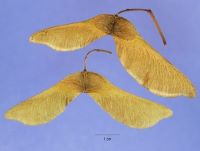 (Neopringlea), 0.8–100 mm long, globoseglobose:
(Neopringlea), 0.8–100 mm long, globoseglobose:
3D shape—more or less spherical to angularangular:
to angularangular:
2D shape—having sides that meet at acute or obtuse angles
, tereteterete:
approximately circular in cross section; width and thickness approximately equal
 in transection, stylestyle:
in transection, stylestyle:
in a flower, the narrow and elongated part of the pistil between the stigma and the ovary; sometimes persisting in fruit or stylestyle:
or stylestyle:
in a flower, the narrow and elongated part of the pistil between the stigma and the ovary; sometimes persisting in fruit remnants often persistent, sometimes beakedbeak:
remnants often persistent, sometimes beakedbeak:
a usually firm, terminal appendage, sometimes tapered , with one to many seeds, often subtended or enclosed by persistent perianthperianth:
, with one to many seeds, often subtended or enclosed by persistent perianthperianth:
collective term for calyx and corolla of a flower
 . Pericarppericarp:
. Pericarppericarp:
fruit wall or fruit coat
brown, black, purple, gray, red, orange, yellow, or green, dully or shinyshiny:
uniformly reflecting a high proportion of incident light at all angles , thin or thick, leatheryleathery:
, thin or thick, leatheryleathery:
texture—moderately thick, tough, and very pliable
, bonybony:
very hard and rather brittle, like bone
, woodywoody:
texture—consisting mainly of indurate lignified tissues, characteristic of or resembling wood
, sometimes fleshy or succulentsucculent:
texture—herbaceous and juicy, often thickened
(berriesberry:
an indehiscent, fleshy fruit with one or a few to many seeds. The flesh may be homogenous throughout. Or, if the outer part is hard, firm, or leathery, referred to as an hesperidium. Septa are present in some, and the seeds may be arillate or with a fleshy testa. ), glabrousglabrous:
), glabrousglabrous:
without hairs
or pubescentpubescent:
surface relief—bearing hairs
(cottony or silky hairs, to 5 mm long), smooth or groovedgrooved:
surface relief—linear depressions that may be single or form a series of grooves over the surface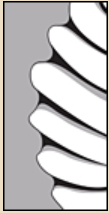 (when dry), striatestriate:
(when dry), striatestriate:
surface relief—having fine, parallel lines, grooves or ridges , ridgedridged:
, ridgedridged:
surface relief—raised, thick ridges, sharp edged or rounded, usually in a series that may cover the entire surface , ribbedribbed:
, ribbedribbed:
surface relief—wide, prominent, linear ridges that are generally rounded and longitudinally situated on the surface , wrinkledwrinkled:
, wrinkledwrinkled:
surface relief—shallow, irregular folds and furrows covering the surface; appearing overall though crumpled and then spread out , veinedveined:
, veinedveined:
surface relief—lines that intersect in a vein pattern that is flush or slightly raised from the surface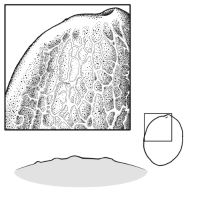 , spinyspiny:
, spinyspiny:
having slender, stiff, sharp projections oriented in the general plane of the structure , bristlybristly:
, bristlybristly:
having bristles or stiff hair or hair-like structures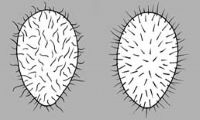 , or with resinous dots or spongyspongy:
, or with resinous dots or spongyspongy:
soft, light, discontinuous but cohesive, and somewhat resilient
emergences.
Seeds usually ovoidovoid:
3D shape—ovate or angularangular:
or angularangular:
2D shape—having sides that meet at acute or obtuse angles
, tereteterete:
approximately circular in cross section; width and thickness approximately equal
 or compressedcompressed:
or compressedcompressed:
flattened; in grasses, used to denote compression (not necessarily flattened) either laterally or dorsiventrally
in transection, 0.3–6 mm (in winged seeds, to 40 mm including wing). Wingless or if winged, dorsally winged or keeledkeel:
a longitudinal ridge, like the keel of a boat, formed by the lengthwise folding of a structure, such as a lemma or palea
 (Abatia). Wings thin, paperypapery:
(Abatia). Wings thin, paperypapery:
texture—papyraceous, chartaceous; very thin, pliable, and readily torn; like paper
or membranousmembranous:
texture—extremely thin, pliable, and fairly tough
, squarish or rectangular and surrounding seed (Itoa, Poliothyrsis) or extending from one end only (Carrierea). Often arillate, arilsaril:
(broad sense) appendicular structure that wholly or partly envelops a seed and is produced from or a modification of the funicle, raphe, or outer integument; usually fleshy or pulpy, sometimes spongy or tufted-capillate, often brightly colored white or red, fleshy, lobed, attached to hilahilum:
white or red, fleshy, lobed, attached to hilahilum:
on seeds, the scar indicating where the funiculus was attached; on grass caryopses, the scar visible on the outer fruit surface revealing where the seed is attached on the inner fruit wall surface; or in Asteraceae cypselae, the scar visible on the outer fruit wall revealing where the fruit was attached to the receptacle . Seed coat black, brown, reddish or purplish brown, gray, green, yellow, or white, rarely mottledmottled:
. Seed coat black, brown, reddish or purplish brown, gray, green, yellow, or white, rarely mottledmottled:
with colored spots, streaks, or blotches of a different color , dulldull:
, dulldull:
reflecting only a low proportion of incident light, with no apparent sheen , rarely shinyshiny:
, rarely shinyshiny:
uniformly reflecting a high proportion of incident light at all angles , glabrousglabrous:
, glabrousglabrous:
without hairs
or pubescentpubescent:
surface relief—bearing hairs
, sometimes densely so, smooth or wartywarty:
surface relief—distinct, rounded projections that are large relative to the fruit size; tuberculate, verrucose , pittedpitted:
, pittedpitted:
surface relief—surface with small depressions in which the areas between the hollows do not take on the appearance of a true reticular net , wrinkledwrinkled:
, wrinkledwrinkled:
surface relief—shallow, irregular folds and furrows covering the surface; appearing overall though crumpled and then spread out , striatestriate:
, striatestriate:
surface relief—having fine, parallel lines, grooves or ridges , punctatepunctate:
, punctatepunctate:
surface relief—dotted with pits or with translucent, sunken glands or with colored dots, similar to pitted , reticulatereticulate:
, reticulatereticulate:
surface relief—netted, raised walls or concave grooves forming a net-like surface pattern with flat, concave, or convex interspaces , or resinous glands. In Salix and Populus, seeds with tuft of long hairs at one end or comacoma:
, or resinous glands. In Salix and Populus, seeds with tuft of long hairs at one end or comacoma:
a tuft of hairs, often attached to the tip of seeds
, sometimes interpreted as arillate.
Embryo well developed, partially to completely filling seed coat, axileaxile:
on or of the axis
and centric, linearlinear:
(shape) long, narrow, and uniform in width; (of embryo) embryo is straight and much longer than wide or foliatefoliate:
or foliatefoliate:
appearing leaf-like
, straight or C-shapedC-shaped:
2D-shape—semiannulate, curved into the shape of the letter 'C'
.
Endosperm or perispermperisperm:
seed nutritive tissue comparable to the endosperm, but derived from the nucellus (maternal tissue)
scanty.
| Fruit | |
| Type | capsulecapsule: a dry, dehiscent fruit derived from a compound ovary  , berryberry: , berryberry:an indehiscent, fleshy fruit with one or a few to many seeds. The flesh may be homogenous throughout. Or, if the outer part is hard, firm, or leathery, referred to as an hesperidium. Septa are present in some, and the seeds may be arillate or with a fleshy testa.  , sometimes drupedrupe: , sometimes drupedrupe:(indehiscent drupe) a fleshy, indehiscent fruit with one more hard pits enclosing seeds, derived from single, superior, simple or compound ovary; (dehiscent drupe) a fruit with a dry or fibrous to fleshy or leathery outer husk that early to tardily breaks apart (or opens), exposing one or more nutlike pits enclosing the seeds  or samarasamara: or samarasamara:a winged, indehiscent, dry fruit containing a single (rarely two) seed(s)  |
| Size range | 0.8–100 mm long |
| Shape(s) | globoseglobose: 3D shape—more or less spherical  , ellipsoidellipsoid: , ellipsoidellipsoid:3D shape—elliptic , oblongoblong: 2D shape—much longer than broad with nearly parallel sides, corners are rounded  , fusiformfusiform: , fusiformfusiform:spindle-shaped; broadest at the middle and tapering at both ends  , ovoidovoid: , ovoidovoid:3D shape—ovate  , conicalconical: , conicalconical:3D shape—cone-shaped, with the point of attachment at the broad end  , pear-shaped, trigonoustrigonous: , pear-shaped, trigonoustrigonous:3D shape—having three faces that meet at distinct angles; triangular in outline , angularangular: 2D shape—having sides that meet at acute or obtuse angles |
| Texture | thin or thick, coriaceouscoriaceous: texture—leathery , bonybony: very hard and rather brittle, like bone , woodywoody: texture—consisting mainly of indurate lignified tissues, characteristic of or resembling wood , sometimes fleshy or succulentsucculent: texture—herbaceous and juicy, often thickened (berriesberry: an indehiscent, fleshy fruit with one or a few to many seeds. The flesh may be homogenous throughout. Or, if the outer part is hard, firm, or leathery, referred to as an hesperidium. Septa are present in some, and the seeds may be arillate or with a fleshy testa.  ) ) |
| Surface relief | smooth, groovedgrooved: surface relief—linear depressions that may be single or form a series of grooves over the surface  (when dry), striatestriate: (when dry), striatestriate:surface relief—having fine, parallel lines, grooves or ridges  , ridgedridged: , ridgedridged:surface relief—raised, thick ridges, sharp edged or rounded, usually in a series that may cover the entire surface  , ribbedribbed: , ribbedribbed:surface relief—wide, prominent, linear ridges that are generally rounded and longitudinally situated on the surface  , wrinkledwrinkled: , wrinkledwrinkled:surface relief—shallow, irregular folds and furrows covering the surface; appearing overall though crumpled and then spread out  , veinedveined: , veinedveined:surface relief—lines that intersect in a vein pattern that is flush or slightly raised from the surface  , spinyspiny: , spinyspiny:having slender, stiff, sharp projections oriented in the general plane of the structure  , bristlybristly: , bristlybristly:having bristles or stiff hair or hair-like structures  , with resinous dots or spongyspongy: , with resinous dots or spongyspongy:soft, light, discontinuous but cohesive, and somewhat resilient emergences |
| Color(s) | brown, black, purple, gray, red, orange, yellow, green |
| Unique features | Usually capsulescapsule: a dry, dehiscent fruit derived from a compound ovary  or berriesberry: or berriesberry:an indehiscent, fleshy fruit with one or a few to many seeds. The flesh may be homogenous throughout. Or, if the outer part is hard, firm, or leathery, referred to as an hesperidium. Septa are present in some, and the seeds may be arillate or with a fleshy testa.  , with numerous often winged and/or pubescentpubescent: , with numerous often winged and/or pubescentpubescent:surface relief—bearing hairs seeds or seeds with white or red fleshy arilsaril: (broad sense) appendicular structure that wholly or partly envelops a seed and is produced from or a modification of the funicle, raphe, or outer integument; usually fleshy or pulpy, sometimes spongy or tufted-capillate, often brightly colored  . . |
| Seed | |
| Size range | 0.3–6 mm long, or if winged up to 40 mm long including wing |
| Shape(s) | usually ovoidovoid: 3D shape—ovate  or angularangular: or angularangular:2D shape—having sides that meet at acute or obtuse angles , sometimes globoseglobose: 3D shape—more or less spherical  , ellipsoidellipsoid: , ellipsoidellipsoid:3D shape—elliptic , oblongoblong: 2D shape—much longer than broad with nearly parallel sides, corners are rounded  , biconical, reniformreniform: , biconical, reniformreniform:2D or 3D shape—kidney-shaped  , lens-shape, cylindricalcylindrical: , lens-shape, cylindricalcylindrical:3D shape—a cylinder, with parallel sides and a circular cross-section; tubular or rod-shaped |
| Surface relief | smooth, wartywarty: surface relief—distinct, rounded projections that are large relative to the fruit size; tuberculate, verrucose  , pittedpitted: , pittedpitted:surface relief—surface with small depressions in which the areas between the hollows do not take on the appearance of a true reticular net  , wrinkledwrinkled: , wrinkledwrinkled:surface relief—shallow, irregular folds and furrows covering the surface; appearing overall though crumpled and then spread out  , striatestriate: , striatestriate:surface relief—having fine, parallel lines, grooves or ridges  , punctatepunctate: , punctatepunctate:surface relief—dotted with pits or with translucent, sunken glands or with colored dots, similar to pitted  , reticulatereticulate: , reticulatereticulate:surface relief—netted, raised walls or concave grooves forming a net-like surface pattern with flat, concave, or convex interspaces  , with resinous glands , with resinous glands |
| Color(s) | black, brown, reddish or purplish brown, gray, green, yellow, white, rarely mottledmottled: with colored spots, streaks, or blotches of a different color  |
| Unique features | Small, often winged or pubescentpubescent: surface relief—bearing hairs , ovoidovoid: 3D shape—ovate  or angularangular: or angularangular:2D shape—having sides that meet at acute or obtuse angles seeds. |
| Other | |
| Embryo | well developed, partially to completely filling seed coat, axileaxile: on or of the axis and centric, linearlinear: (shape) long, narrow, and uniform in width; (of embryo) embryo is straight and much longer than wide  or foliatefoliate: or foliatefoliate:appearing leaf-like , straight or C-shapedC-shaped: 2D-shape—semiannulate, curved into the shape of the letter 'C' |
| Nutritive tissue | endosperm or perispermperisperm: seed nutritive tissue comparable to the endosperm, but derived from the nucellus (maternal tissue) scanty |
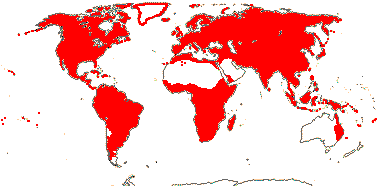
Distribution map courtesy of Angiosperm Phylogeny Website.
Bingham et al. 2021+Bingham et al. 2021+:
Bingham MG, Willeman A, Wursten BT, Ballings P, and Hyde MA. 2021. Flora of Zambia. Accessed January 2021–April 2024. URL: https://www.zambiaflora.com; Chase et al. 2002Chase et al. 2002:
Chase MW, Zmarzty S, Lledó MD, Wurdack K J, Swensen S M, and Fay MF. 2002. When in doubt, put it in Flacourtiaceae: A molecular phylogenetic analysis based on plastid rbcL DNA sequences. Kew Bulletin 57: 141&-181.; Goldberg 1986Goldberg 1986:
Goldberg A. 1986. Classification, Evolution, and Phylogeny of the Families of Dicotyledons. Smithsonian Contributions to Botany. pp 314. https://doi.org/10.5479/si.0081024X.58; Flora of North America Editorial Committee 1993+Flora of North America Editorial Committee 1993+:
Flora of North America Editorial Committee, eds. 1993+. Flora of North America North of Mexico [Online]. 22+ vols. Flora of North America Association, New York and Oxford. Accessed January-March 2024. URL: http://beta.floranorthamerica.org.; Hyde et al. 2021b+Hyde et al. 2021b+:
Hyde MA, Wursten BT, Ballings P, and Coates Palgrave M. 2021b. Flora of Mozambique. Accessed January 2021–April 2024. URL: https://www.mozambiqueflora.com/index.php; Kirkbride et al. 2006Kirkbride et al. 2006:
Kirkbride JH, Jr, Gunn CR, and Dallwitz MJ. 2006. Family guide for fruits and seeds, vers. 1.0. Accessed September 2020-January 2022. URL: https://nt.ars-grin.gov/seedsfruits/keys/frsdfam/index.cfm .; Masters 1871Masters 1871:
Masters MT. 1871. Samydaceae. In: Flora of Tropical Africa, Oliver D, ed, Vol 2. L. Reeve and co., London. pp. 492&-500.; Sleumer 1954Sleumer 1954:
Sleumer HO. 1954. Flacourtiaceae. In: Flora Malesiana, van Steenis-Kruseman MJ, ed, Ser 1, Vol. 5. Noordhoff-Kolff, Djakarata. 106 pp.; Sleumer 1975Sleumer 1975:
Sleumer HO. 1975. Flacourtiaceae. In: Flora of Tropical East Africa, Beentje HJ, ed. Royal Botanic Gardens, Kew, UK. 68 pp.; Sleumer 1980Sleumer 1980:
Sleumer HO. 1980. Flacourtiaceae. Flora Neotropica 22:55&-57.; Takhtajan 2009Takhtajan 2009:
Takhtajan A. 2009. Flowering plants: Second edition. Springer Nature, Switzerland. 871 pp.; van Heel 1967; Zhengyi et al. 2004+Zhengyi et al. 2004+:
Zhengyi W, Raven PH, and Deyuan H. 2004+. Flora of China [online]. 25 vols. Science Press, Beijing China & Missouri Botanical Garden, St. Louis USA. Accessed January–March 2024. http://flora.huh.harvard.edu/china/
*The number of genera and species is based on Christenhusz and Byng 2016Christenhusz and Byng 2016:
Christenhusz MJM and Byng JW. 2016. The number of known plant species in the world and its annual increase. Phytotaxa 261 (3): 201-217. https://doi.org/10.11646/phytotaxa.261.3.1, which may differ from the number of genera in GRIN-Global.